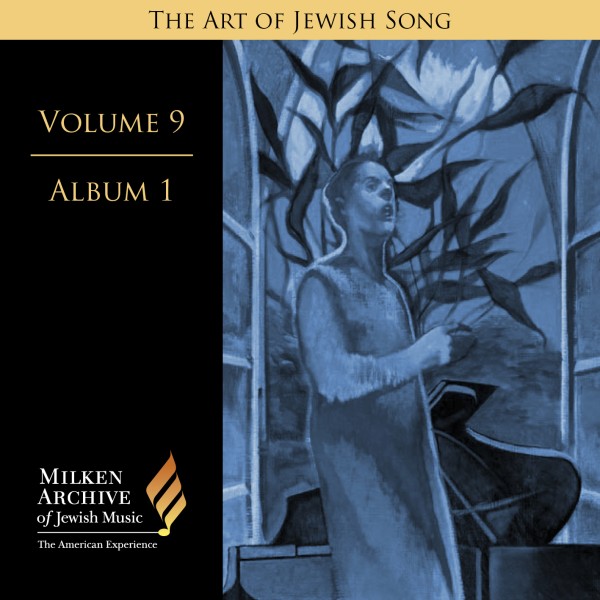Paul Lamkoff was a composer, songwriter, choral director, and film score arranger and orchestrator who also served the Los Angeles Jewish community for a number of years as a cantor. He is best remembered, however, for his Yiddish songs, a few of which became well known in Yiddish musical circles through their recordings by important exponents of the art.
Little reliable information has surfaced thus far regarding Lamkoff’s European years, prior to his immigration to the United States in the early 1920s. Claims concerning his European musical education that appeared in the Los Angeles press remain uncorroborated, and information about his California years is only slightly less vague.
A New York Times obituary gave Lamkoff’s country of birth as Poland, without identifying a city or region (American press references during his lifetime also neglected to identify either). The obituary in the Los Angeles Times, however, gave his birthplace simply as “Russia,” as did the 1930 U.S. Census population schedule for Los Angeles County—which also lists Russia as the birthplace of his parents. One might be tempted to conclude that he was a native of what was known until the Bolshevik Revolution as “Russian Poland” (the part of Poland that was part of the former Czarist Empire), as immigrants from parts of the empire other than Russia proper (Ukraine, Belarus, etc.) frequently identified their former country as Russia. However, in 1930, Poland was an independent nation, and Russia was part of the U.S.S.R.; and the census document specifically requested the name of the country “in which birthplace is now situated.” That same census document also lists Lamkoff’s primary language prior to immigration (“language spoken in home before coming to the United States”) as Russian. In any case, according to the census record, he entered the United States in 1922 and was living in Los Angeles by 1930, having identified his principal occupation as “composer,” the “industry” given as “movie studio.” This suggests that the lure of Hollywood could have been the motivation for his relocation to Los Angeles within a few years of arriving in New York—a magnet for many other émigré musicians.
Los Angeles Jewish newspaper accounts during Lamkoff’s lifetime refer to his having studied at conservatories in Poland and Russia—or sometimes to “Warsaw and Petrograd” (St. Petersburg)— without identifying the actual institutions. An announcement of his completion in 1944 of an orchestral work on Jewish historical themes mentions his studies with Rimsky-Korsakov and Glazunov. Both did teach at the world-renowned St. Petersburg Conservatory, but Lamkoff’s name has yet to surface in any of the pertinent documentary literature or studies concerning their few Jewish students. Similarly, our knowledge of Lamkoff’s career in Europe prior to the age of thirty-four, when he emigrated, is hazy and unspecified, beyond occasional passing references to his having “conducted symphony orchestras and opera in Europe.” Yet those Jewish press items must have been based on whatever information he furnished—either directly or through the synagogue at which he was employed at the time in Los Angeles—so that the vagueness surrounding such important factors remains a mystery.
Los Angeles press accounts also refer to Lamkoff’s having been a successful boy (wunderkind) cantor in eastern Europe by the age of eleven. Depending on what that cantorial characterization was meant to signify or imply, some such achievement was not entirely impossible. It must be observed nonetheless that the phenomenon of boy cantors who actually functioned as sh’likhei tzibbur (messengers of the congregation) under the age of thirteen—and thus before the legal majority status of bar mitzvah and the accompanying obligation to observe the Commandments—was largely an American occurrence during the eastern European immigration era. From what we can glean based on the scant available information, that phenomenon appears to have been facilitated in some nominally orthodox American synagogue circles of the time by the pliancy or lack altogether of enforceable rabbinical authority on the European model.
We do know that beginning in the 1930s, Lamkoff served various cantorial pulpits in Los Angeles together with traditional choirs—most notably, Temple Beth El of Hollywood. And his involvement with Jewish choruses was not limited to the synagogue. On the recommendation of the eminent émigré violinist and composer Joseph Achron, who had settled in Los Angeles after emigrating from St. Petersburg via Palestine and New York, Lamkoff was engaged to conduct the chorus of the local chapter of the musical advocacy group MAILAMM (Achron was one of the founders of the Los Angeles branch, in connection with which the MAILAMM Chorus was founded in 1937).
Lamkoff worked as an arranger, film scorer, and general music assistant and editor at Metro-Goldwyn-Mayer and Warner Bros. studios in Hollywood, and as a freelance consultant for Jewish musical components of motion pictures and a choral preparer of ensembles for other studios. He is said to have been involved with the preparation of the sound track for The Jazz Singer, featuring Al Jolson, known as the first “talking picture” among American-made feature films. The New York Times obituary also referred to his having directed the music as well as having sung in the chorus of the original The King of Kings, produced by Cecil B. DeMille; and it indicated that he was involved in the musical direction and some composing for the first remake of The Jazz Singer.
Among Lamkoff’s compositions outside the motion-picture industry are a symphony, programmatically titled Survival of a Nation, completed in Los Angeles in 1944; a collection of ten Hebrew songs arranged for voice and piano and published in 1929; a choral piece to words by Solomon Golub for the United Hebrew Choral Societies of the United States and Canada, written in 1923; and a body of original Yiddish songs, some of which became part of the repertoire of such leading advocates of Yiddish art song as the celebrated Sidor Belarsky.
By: Neil W. Levin
